Input interpretation

O_2 oxygen + CH_4 methane ⟶ H_2 hydrogen + CO carbon monoxide
Balanced equation
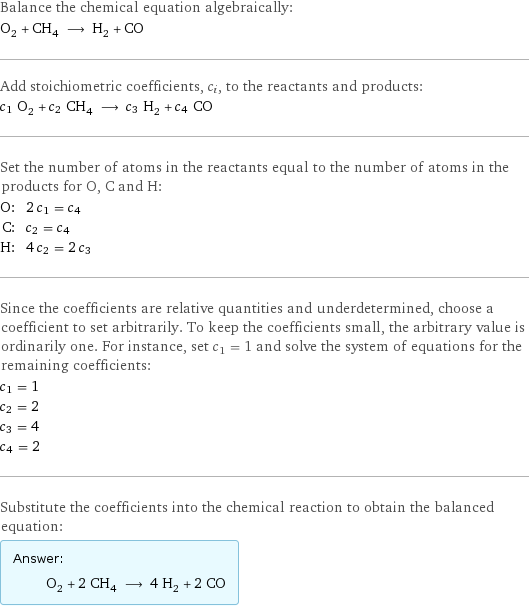
Balance the chemical equation algebraically: O_2 + CH_4 ⟶ H_2 + CO Add stoichiometric coefficients, c_i, to the reactants and products: c_1 O_2 + c_2 CH_4 ⟶ c_3 H_2 + c_4 CO Set the number of atoms in the reactants equal to the number of atoms in the products for O, C and H: O: | 2 c_1 = c_4 C: | c_2 = c_4 H: | 4 c_2 = 2 c_3 Since the coefficients are relative quantities and underdetermined, choose a coefficient to set arbitrarily. To keep the coefficients small, the arbitrary value is ordinarily one. For instance, set c_1 = 1 and solve the system of equations for the remaining coefficients: c_1 = 1 c_2 = 2 c_3 = 4 c_4 = 2 Substitute the coefficients into the chemical reaction to obtain the balanced equation: Answer: | | O_2 + 2 CH_4 ⟶ 4 H_2 + 2 CO
Structures

+ ⟶ +
Names

oxygen + methane ⟶ hydrogen + carbon monoxide
Reaction thermodynamics
Enthalpy
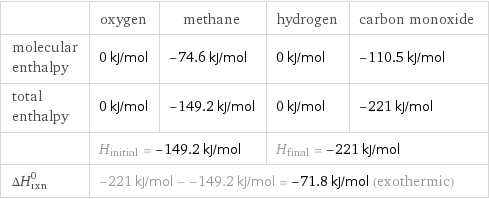
| oxygen | methane | hydrogen | carbon monoxide molecular enthalpy | 0 kJ/mol | -74.6 kJ/mol | 0 kJ/mol | -110.5 kJ/mol total enthalpy | 0 kJ/mol | -149.2 kJ/mol | 0 kJ/mol | -221 kJ/mol | H_initial = -149.2 kJ/mol | | H_final = -221 kJ/mol | ΔH_rxn^0 | -221 kJ/mol - -149.2 kJ/mol = -71.8 kJ/mol (exothermic) | | |
Gibbs free energy
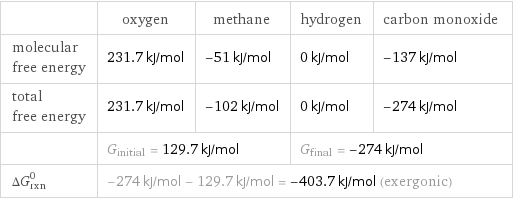
| oxygen | methane | hydrogen | carbon monoxide molecular free energy | 231.7 kJ/mol | -51 kJ/mol | 0 kJ/mol | -137 kJ/mol total free energy | 231.7 kJ/mol | -102 kJ/mol | 0 kJ/mol | -274 kJ/mol | G_initial = 129.7 kJ/mol | | G_final = -274 kJ/mol | ΔG_rxn^0 | -274 kJ/mol - 129.7 kJ/mol = -403.7 kJ/mol (exergonic) | | |
Entropy
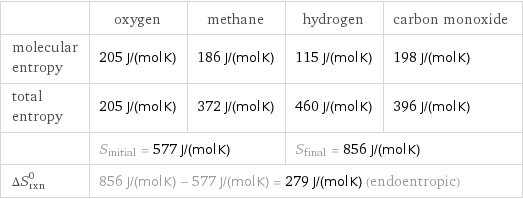
| oxygen | methane | hydrogen | carbon monoxide molecular entropy | 205 J/(mol K) | 186 J/(mol K) | 115 J/(mol K) | 198 J/(mol K) total entropy | 205 J/(mol K) | 372 J/(mol K) | 460 J/(mol K) | 396 J/(mol K) | S_initial = 577 J/(mol K) | | S_final = 856 J/(mol K) | ΔS_rxn^0 | 856 J/(mol K) - 577 J/(mol K) = 279 J/(mol K) (endoentropic) | | |
Equilibrium constant
![Construct the equilibrium constant, K, expression for: O_2 + CH_4 ⟶ H_2 + CO Plan: • Balance the chemical equation. • Determine the stoichiometric numbers. • Assemble the activity expression for each chemical species. • Use the activity expressions to build the equilibrium constant expression. Write the balanced chemical equation: O_2 + 2 CH_4 ⟶ 4 H_2 + 2 CO Assign stoichiometric numbers, ν_i, using the stoichiometric coefficients, c_i, from the balanced chemical equation in the following manner: ν_i = -c_i for reactants and ν_i = c_i for products: chemical species | c_i | ν_i O_2 | 1 | -1 CH_4 | 2 | -2 H_2 | 4 | 4 CO | 2 | 2 Assemble the activity expressions accounting for the state of matter and ν_i: chemical species | c_i | ν_i | activity expression O_2 | 1 | -1 | ([O2])^(-1) CH_4 | 2 | -2 | ([CH4])^(-2) H_2 | 4 | 4 | ([H2])^4 CO | 2 | 2 | ([CO])^2 The equilibrium constant symbol in the concentration basis is: K_c Mulitply the activity expressions to arrive at the K_c expression: Answer: | | K_c = ([O2])^(-1) ([CH4])^(-2) ([H2])^4 ([CO])^2 = (([H2])^4 ([CO])^2)/([O2] ([CH4])^2)](../image_source/67f1096998b5b5b8c60e0d089a06ae80.png)
Construct the equilibrium constant, K, expression for: O_2 + CH_4 ⟶ H_2 + CO Plan: • Balance the chemical equation. • Determine the stoichiometric numbers. • Assemble the activity expression for each chemical species. • Use the activity expressions to build the equilibrium constant expression. Write the balanced chemical equation: O_2 + 2 CH_4 ⟶ 4 H_2 + 2 CO Assign stoichiometric numbers, ν_i, using the stoichiometric coefficients, c_i, from the balanced chemical equation in the following manner: ν_i = -c_i for reactants and ν_i = c_i for products: chemical species | c_i | ν_i O_2 | 1 | -1 CH_4 | 2 | -2 H_2 | 4 | 4 CO | 2 | 2 Assemble the activity expressions accounting for the state of matter and ν_i: chemical species | c_i | ν_i | activity expression O_2 | 1 | -1 | ([O2])^(-1) CH_4 | 2 | -2 | ([CH4])^(-2) H_2 | 4 | 4 | ([H2])^4 CO | 2 | 2 | ([CO])^2 The equilibrium constant symbol in the concentration basis is: K_c Mulitply the activity expressions to arrive at the K_c expression: Answer: | | K_c = ([O2])^(-1) ([CH4])^(-2) ([H2])^4 ([CO])^2 = (([H2])^4 ([CO])^2)/([O2] ([CH4])^2)
Rate of reaction
![Construct the rate of reaction expression for: O_2 + CH_4 ⟶ H_2 + CO Plan: • Balance the chemical equation. • Determine the stoichiometric numbers. • Assemble the rate term for each chemical species. • Write the rate of reaction expression. Write the balanced chemical equation: O_2 + 2 CH_4 ⟶ 4 H_2 + 2 CO Assign stoichiometric numbers, ν_i, using the stoichiometric coefficients, c_i, from the balanced chemical equation in the following manner: ν_i = -c_i for reactants and ν_i = c_i for products: chemical species | c_i | ν_i O_2 | 1 | -1 CH_4 | 2 | -2 H_2 | 4 | 4 CO | 2 | 2 The rate term for each chemical species, B_i, is 1/ν_i(Δ[B_i])/(Δt) where [B_i] is the amount concentration and t is time: chemical species | c_i | ν_i | rate term O_2 | 1 | -1 | -(Δ[O2])/(Δt) CH_4 | 2 | -2 | -1/2 (Δ[CH4])/(Δt) H_2 | 4 | 4 | 1/4 (Δ[H2])/(Δt) CO | 2 | 2 | 1/2 (Δ[CO])/(Δt) (for infinitesimal rate of change, replace Δ with d) Set the rate terms equal to each other to arrive at the rate expression: Answer: | | rate = -(Δ[O2])/(Δt) = -1/2 (Δ[CH4])/(Δt) = 1/4 (Δ[H2])/(Δt) = 1/2 (Δ[CO])/(Δt) (assuming constant volume and no accumulation of intermediates or side products)](../image_source/d06e792d923595fb1e2dbc001bfd253e.png)
Construct the rate of reaction expression for: O_2 + CH_4 ⟶ H_2 + CO Plan: • Balance the chemical equation. • Determine the stoichiometric numbers. • Assemble the rate term for each chemical species. • Write the rate of reaction expression. Write the balanced chemical equation: O_2 + 2 CH_4 ⟶ 4 H_2 + 2 CO Assign stoichiometric numbers, ν_i, using the stoichiometric coefficients, c_i, from the balanced chemical equation in the following manner: ν_i = -c_i for reactants and ν_i = c_i for products: chemical species | c_i | ν_i O_2 | 1 | -1 CH_4 | 2 | -2 H_2 | 4 | 4 CO | 2 | 2 The rate term for each chemical species, B_i, is 1/ν_i(Δ[B_i])/(Δt) where [B_i] is the amount concentration and t is time: chemical species | c_i | ν_i | rate term O_2 | 1 | -1 | -(Δ[O2])/(Δt) CH_4 | 2 | -2 | -1/2 (Δ[CH4])/(Δt) H_2 | 4 | 4 | 1/4 (Δ[H2])/(Δt) CO | 2 | 2 | 1/2 (Δ[CO])/(Δt) (for infinitesimal rate of change, replace Δ with d) Set the rate terms equal to each other to arrive at the rate expression: Answer: | | rate = -(Δ[O2])/(Δt) = -1/2 (Δ[CH4])/(Δt) = 1/4 (Δ[H2])/(Δt) = 1/2 (Δ[CO])/(Δt) (assuming constant volume and no accumulation of intermediates or side products)
Chemical names and formulas
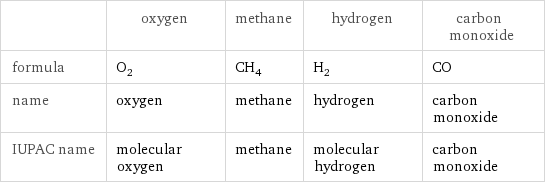
| oxygen | methane | hydrogen | carbon monoxide formula | O_2 | CH_4 | H_2 | CO name | oxygen | methane | hydrogen | carbon monoxide IUPAC name | molecular oxygen | methane | molecular hydrogen | carbon monoxide
Substance properties
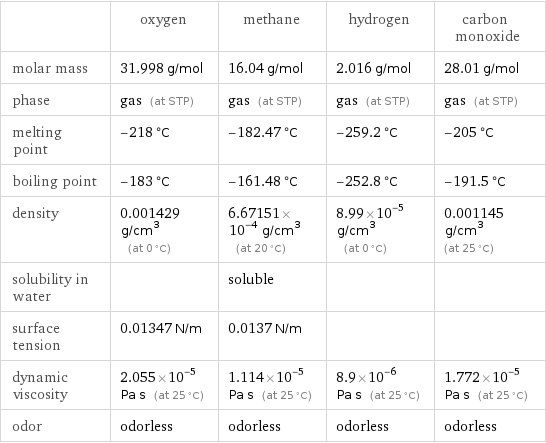
| oxygen | methane | hydrogen | carbon monoxide molar mass | 31.998 g/mol | 16.04 g/mol | 2.016 g/mol | 28.01 g/mol phase | gas (at STP) | gas (at STP) | gas (at STP) | gas (at STP) melting point | -218 °C | -182.47 °C | -259.2 °C | -205 °C boiling point | -183 °C | -161.48 °C | -252.8 °C | -191.5 °C density | 0.001429 g/cm^3 (at 0 °C) | 6.67151×10^-4 g/cm^3 (at 20 °C) | 8.99×10^-5 g/cm^3 (at 0 °C) | 0.001145 g/cm^3 (at 25 °C) solubility in water | | soluble | | surface tension | 0.01347 N/m | 0.0137 N/m | | dynamic viscosity | 2.055×10^-5 Pa s (at 25 °C) | 1.114×10^-5 Pa s (at 25 °C) | 8.9×10^-6 Pa s (at 25 °C) | 1.772×10^-5 Pa s (at 25 °C) odor | odorless | odorless | odorless | odorless
Units
